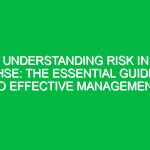Welcome Team!
Good morning, everyone! Today, we’re gathered for our Toolbox Talk to discuss a crucial concept in our Health, Safety, and Environment (HSE) practices: What is Your “Why”? Understanding our “why” is essential for fostering a Safety culture and ensuring that our daily operations are carried out with the highest regard for Safety. By the end of this talk, I hope you will see the importance of anchoring your actions in a clear purpose, which will not only enhance your safety but also contribute to our overall HSE success.
Understanding Your “Why”
When we talk about What is Your “Why” in the context of HSE, we are referring to the underlying reasons and motivations behind our safety practices. It’s about recognizing why safety matters—not just for compliance, but for the well-being of ourselves, our colleagues, and our families. This understanding transforms safety from a set of rules into a deeply personal commitment.
The Importance of Knowing Your “Why”
Let’s delve deeper into why knowing your “why” is vital:
- Enhances Commitment: When you understand your personal motivation for safety, you are more likely to adhere to safety protocols and encourage others to do the same.
- Increases Awareness: A clear “why” fosters a heightened awareness of potential Hazards, making you more proactive in identifying and mitigating risks.
- Promotes Team Cohesion: Sharing your “why” with colleagues can strengthen bonds and create a supportive environment where everyone looks out for each other.
- Improves Decision-Making: Knowing your motivations can guide your choices in challenging situations, helping you prioritize safety over shortcuts.
Real-Life Example: The Importance of Your “Why”
Let’s consider a scenario. Imagine a construction site where workers are tired, and the pressure to meet deadlines is high. One worker, John, knows that his “why” is his family. He thinks about his children waiting for him at home. This thought compels him to double-check his Safety Gear and raise concerns when he notices a colleague about to take a risky shortcut. In contrast, another worker, who hasn’t reflected on their “why,” might choose to ignore safety protocols, leading to a near-miss incident. This example illustrates how personal motivations can significantly influence safety behaviors on the job site.
Identifying Your “Why”
Now that we understand the importance of knowing our “why,” let’s explore how to identify it. Here are some steps to help you articulate your personal motivations for safety:
- Reflect on Your Values: Consider what matters most to you. Is it your family, your health, your career, or your colleagues? Write these down.
- Think About Experiences: Reflect on past experiences where safety was compromised. How did those situations affect you and those around you?
- Visualize the Future: Imagine the consequences of unsafe practices. What do you want your future to look like? How does safety fit into that vision?
- Share with Others: Discuss your thoughts with colleagues. Sharing your “why” can help solidify your beliefs and promote a culture of safety.
Encouraging Team Discussions
As we explore our individual “whys,” I encourage everyone to engage in discussions with your teammates. You can ask open-ended questions like:
- What motivates you to prioritize safety at work?
- Can you share a personal experience that has shaped your views on safety?
- How can we support each other in our safety commitments?
Best Practices for Keeping Your “Why” Alive
Once you’ve identified your “why,” it’s essential to keep it alive in your daily work. Here are some Best Practices:
- Set Personal Goals: Create specific, measurable safety goals that align with your “why.” For example, commit to always wearing your safety helmet or reporting unsafe conditions.
- Stay Informed: Continuously educate yourself about safety protocols and Best Practices. Knowledge can reinforce your commitment to safety.
- Lead by Example: Be a role model for others in your team. When your colleagues see your commitment, they may be inspired to reflect on their “why” as well.
- Celebrate Safety Wins: Acknowledge and celebrate when safety goals are met, whether individually or as a team. This reinforces the importance of safety in achieving our objectives.
Potential Hazards and Risks
Understanding What is Your “Why” also involves recognizing potential hazards and risks that may arise in your work environment. Here are a few considerations:
- Physical Hazards: Machinery, tools, and environmental factors can pose significant risks. Always be aware of your surroundings and the equipment you are using.
- Behavioral Risks: Fatigue, distractions, and complacency can lead to unsafe behaviors. It’s essential to address these factors proactively.
- Psychological Hazards: Stress and mental health can impact safety performance. Support one another and foster an environment where individuals feel comfortable discussing their mental well-being.
Compliance and Legal Obligations
Complying with Regulations and safety Standards is another critical aspect of understanding your “why.” Regulations, such as OSHA standards, are not just bureaucratic hurdles; they are designed to protect you and your colleagues. Here’s how compliance impacts safety:
- Protects Your Rights: Compliance ensures that your workplace meets safety standards, safeguarding your right to work in a safe environment.
- Avoids Legal Issues: Adhering to regulations helps prevent accidents and legal liabilities that could arise from unsafe practices.
- Enhances Company Reputation: A commitment to safety improves the organization’s reputation, leading to greater trust from clients and stakeholders.
Conclusion
In summary, understanding What is Your “Why” is not just a personal journey; it is a collective responsibility that enhances our safety culture. By reflecting on our motivations, sharing our experiences, and committing to safety practices, we can create a safer workplace for ourselves and our colleagues. Remember, safety is not just about following rules; it’s about making a conscious decision to protect ourselves and those around us.
Thank you all for your attention today and for your commitment to maintaining a safe working environment. Let’s take our understanding of our “why” and apply it in our daily operations, ensuring that safety remains a priority every step of the way.


